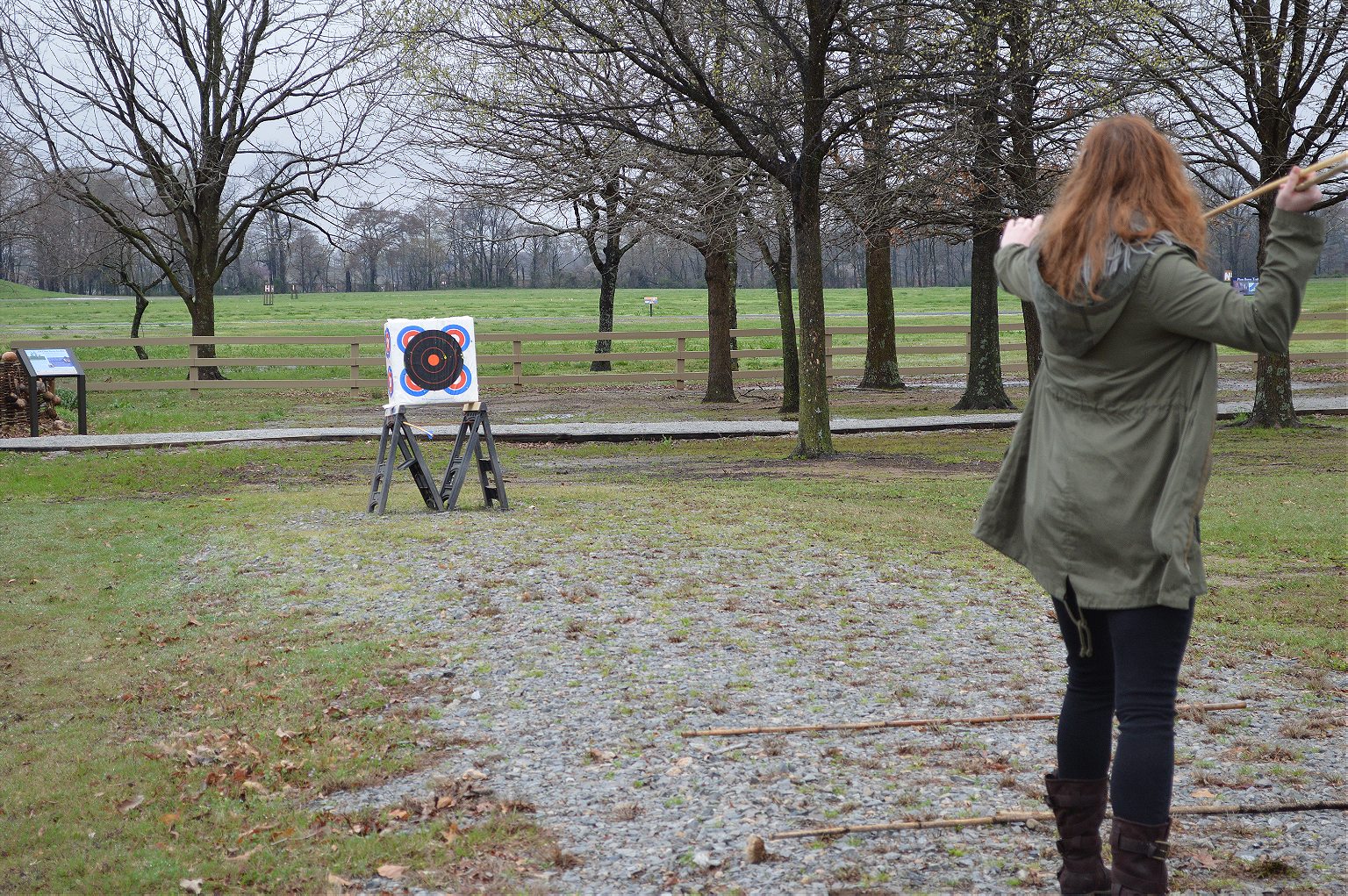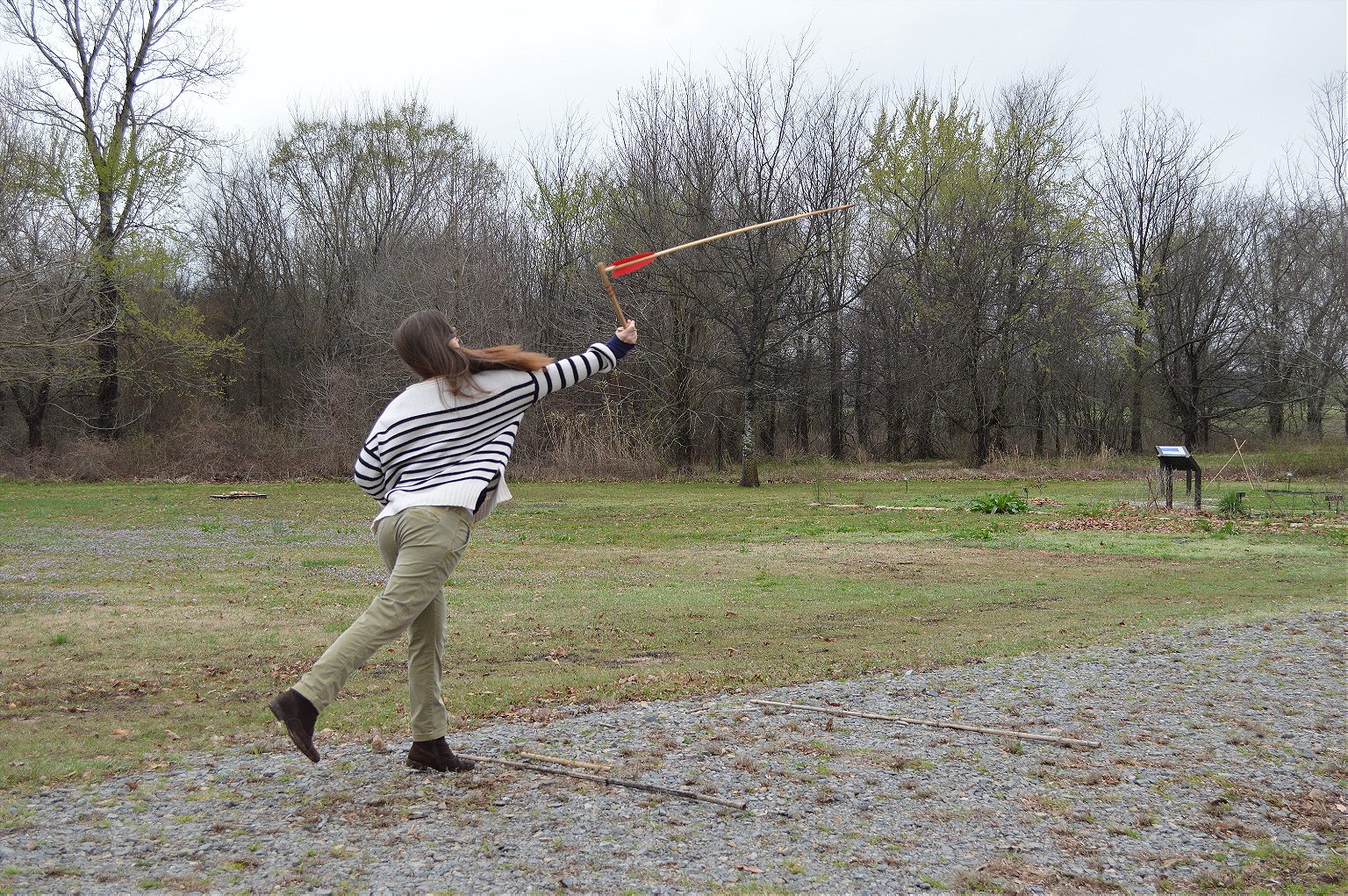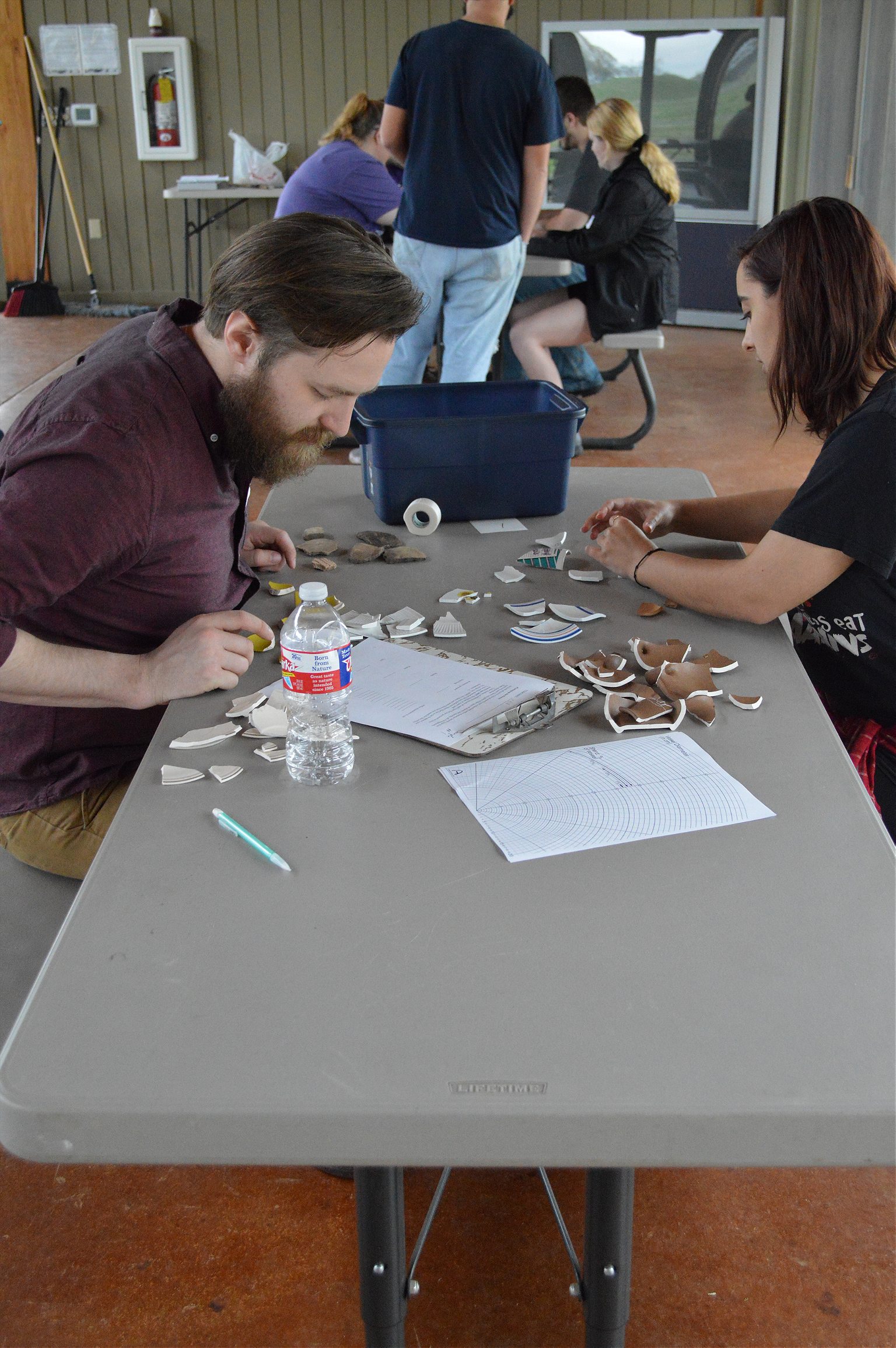Meet the champions of spear throwing, flint knapping, and stone throwing.
The first time I met a flint knapper was in college. A lanky man with stringy, sandy blond hair, he looked like a young Andy Warhol rocking an understated cowboy style. He was an archaeologist of the pre-Columbian American Southwest and had a deep respect for his colleagues, students, and research subjects. The man would rhapsodize about the ingenuity and oft-neglected humanity behind the Native American ruins dotting the country. And he claimed that flint knapping—hand-making stone tools—was a great way to develop that emotive connection to the past. It could teach you the level of skill and inventiveness involved in making an arrowhead or obsidian knife, things we often think of (consciously or subconsciously) as a primitive technologies.
It was also a great way to cut the living shit out of your fingers. Flint knapping (or lithic reduction, as the fancy folks call it) involves taking a flakey stone—like chert or, well, flint—and using a harder rock, like sandstone or quartzite, to chip away chunks and slivers. Balancing force and angle, a skilled knapper can carve out rough yet functional shapes, sometimes refining them with more delicate tools such as bone, antler, or wood. The results are precise, sharp stone instruments. But the process also means you send razor-edged leaves of stone flying, slicing flesh and sometimes jumping dangerously toward your eyes. And even after years of practice, this professor, by his own account, still managed to slice and dice his digits on a regular basis, to say nothing of the students who sometimes joined him in his endeavors.
At the time, I thought this man was a rare and eccentric experimental archaeologist. But over the years, I met others like him: not all flint knappers, but folks who’d taken up other ancient skills. Some were archaeologists, like the woman who kept an atlatl—an early mechanical device used to launch spears—and a set of projectiles in her office. Some were laypeople, like the craftsman who taught himself how to make cordage—varied ropes—out of raw materials. These folks occasionally unite, not just to meet and swap stories, but for competitive games of pre-industrial skill. They put on all sorts of competitions, but in recent years a few contests have popped up around the country with a common pedagogical goal and the potential to draw new and wider generations into this diffuse yet like-minded subculture. They call these informal contests “Archaeolympics.”

It’s hard to define Archaeolympics succinctly because every set of games is a little different. Some are tiny one-offs organized by professional outfits for their employees or local groups trying to get kids interested in history by flinging spears. (Or rather, in the case of newbies, by awkwardly plopping spears a few feet into the ground.) Others are big to-dos, like the now-defunct Seminole Canyon State Park Archaeolympics, which ran from 2008 to 2015.
Organized by Texas Parks and Wildlife on the rocky plains of the lower Pecos region, a land which screams Paleolithic, these Archaeolympics were open to all, with atlatl tossing, fire-starting races, and rabbit stick throwing. The first two events look rather professional: people crouching intently over kindling and methodically running their hands down sticks to make a fire with friction energy or releasing a javelin from their atlatls in a fluid motion, tracing long and graceful arks into hay-bale targets. The rabbit stick competition, on the other hand, while treated with the same solemnity, feels a bit sillier. An early form of hunting, people the world over used curved cudgels—often dubbed “non-returning boomerangs”—to whack small prey from afar with precision. But despite their measured throws, it’s rare to find footage of a Seminole Creek Archaeolympic contestant scoring a hit on one of the balls placed on a throwing range. Instead, their sticks inevitably veer off wildly, and it often seems as if these serious contestants, so graceful and precise with atlatls, take that a bit hard.
Of the large-scale games, some concern themselves primarily with fun. A set of games organized by The College of New Jersey last November targeted regional students and drew about 200 people spectators eager to watch amateurs fumbling about and enjoy “paleo refreshments.” (For that latter term, think foraged items, rather than trendy smoothies from the Paleo diet movement.) Frat boys and anthropology wonks alike got to try their hands at atlatl throwing, cordage making, fire starting, flint knapping, and cobble tossing. That last event is perhaps one of the most basic ancient skills: learning to accurately throw large stones at a target. But it’s also, well, just chucking stones, which might seem silly even to a discus thrower used to launching better-crafted objects.
Others, like the Archaeolympics at the Toltec Mounds Archaeological State Park (just 16 miles southeast of Little Rock, Arkansas), are smaller affairs, but take themselves especially seriously as pedagogical endeavors. Drawing a more selective group of students and banning pros or experienced archaeoathletes, they took the trouble of drawing up a comprehensive rulebook for their first games last March. Their games were a mix of pre-industrial and professional archaeological skills, featuring both atlatl throwing and a contest in which students had to sift through buckets of dirt to find, identify, and classify “unearthed” objects. That’s an endeavor useful to the students, but a bit duller to watch.
The common force driving individuals across the nation towards Archaeolympics is the desire to draw people into history and archaeology. Elizabeth Borland, the TCNJ professor who set up their games, wanted to revive regional universities’ archaeology clubs and societies, while Elizabeth Horton and Krista Lewis, an archeologist at Toltec Mounds and an archaeologist at the University of Arkansas at Little Rock, respectively, wanted to give students a “hands-on” feel for history and a forum in which to meet experienced archaeological professionals. But they resonate with more than just students—especially games like those at the Town Creek Indian Mound State Historic Site near Mt. Gilead, North Carolina, which focus on skill games like “chunkey,” a contest in which you roll a stone across the ground and try to throw a spear close to where it will land. Originating in Cahokia about 1,400 years ago, the game became insanely popular throughout the American Southeast, enduring past European contact in some pockets, even well into the 1800s. With complex rules and dense history behind it, not to mention potential prizes or bragging rights about skills, chunkey and games like it draw in serious and skilled participants alike.
Whether thanks to the fun of chucking spears and starting fires or simply the desire to experience ancient life in modern times, the games are growing in popularity. Horton notes that after her games, a few new archaeological clubs opened up throughout the state, and an atlatl event she and Lewis hosted last week alone drew in almost double the number of contestants at their inaugural Archaeolympics. But the rise of Archaeolympics is also likely part of a broader rising tide of interest in pre-industrial skills amongst the general public.

To hear Horton tell it, archaeologists are primed by their nature to get into ancient skills. “In my experience, the kind of people who go into the sciences are fundamentally ‘kids,’” she says. “None of us are trying to, or interested in, living a pre-industrial life. But because this is the material culture that we encounter in our research, we simply tend to want to know just about everything we possibly can about it.” And that often means trying your hand at it.
Yet according to Borland, these days some of the most engaged practitioners of pre-industrial skills, whose expertise is vital in setting up Archaeolympics and training students, are removed from the field of professional archaeology. The man she consulted for her atlatl competition, Eric Zeh, is a machinist, but also a third-generation arrowhead collector. And an amateur flint knapper who declined to participate in her Archaeolympics still guided her through the quality of different stones in great detail one day purely out of passion for the skill.
You’ll often hear about how more and more people are exploring flint knapping, cordage making, or fire starting. But the rise in pre-industrial skill hobbies in America is perhaps clearest in atlatl tossing. A globally dispersed technology, most archaeologists, no matter their area of expertise, will be exposed to it—hence their predisposition. But for amateurs and outsiders, the atlatl is easy to learn in a basic sense, but hard to master (it requires more art than brawn, making it egalitarian as well both between genders and for folks who might not be great at many modern sports), making it both tantalizing and just plain cool. While a novice might fumble a projectile off a launcher once or twice, it’s pretty easy to start tracing long and impressive arcs through the sky, which feels exhilarating, even if it’s technically so-so. It’s also cheaper and safer than most other flashy weapons-based skills like tomahawk throwing (which is a great way to do some property damage to your siding) or even flesh-rending flint knapping.
According to Bob Berg, the founder of the manufacturing firm Thunderbird Atlatl in Candor, New York, and an atlatlist for almost three decades (who wants to make sure we all know it’s pronounced at-latl, not atl-atl), atlatl sales have been on the rise for years. “When I first started this thing,” he says of his business, founded in 1996, “there were maybe hundreds of people who knew about atlatls… [Now] we sell thousands of them every year, so I’ve gotta say that there’s [probably] about a quarter of a million people that actually have these kind of things.”
Berg credits some of this rise to the revival of atlatl hunting, which he’s played a huge part in reviving. When he started out, only a few dozen people knew how to hunt with atlatls, and their use was only legal in Alaska. Now, three more states have made allowances for such hunts. But Berg thinks hunters account for just about a tenth of his sales. The rest he credits to a general increase in interest in the revival of pre-industrial skills, both among cultures interested in reviving elements of their traditional heritage (Native American tribes call him in to help teach atlatl hunting) and among those with no direct connection to the sport. Some of this wider audience, he thinks, is in it for survivalist reasons—a paranoid belief in the need to prepare for the end times, which will blow us all back to the stone age. But the rest, he thinks, just feel some intrinsic pull to save, relish, or celebrate a world that seems near extinction.
“We’re at a point in civilization where if we don’t reach back and grab these skills and bring ‘em forward,” he grumbles, “we’re going to lose ‘em. You know what I mean?”

Larger Archaeolympics—public events advertised through universities, state parks, and other organizations—are a powerful vector for bringing people into the fold of serious pre-industrial pursuits. They give archaeologists a platform to promote their discipline and diehard pre-industrial skill learners a place to strut their stuff, recruiting young people in the process. (Many amateur practitioners are motivated by a desire to teach the next generation, either through the Archaeolympics or programs like the Boy Scouts that might welcome them to teach a class or two.) Archaeolympics are a feedback loop—at once a reflection and facilitator of a growing trend. The more people find themselves entranced by an atlatlist or flint knapper and the connection to the past they represent, whether at first by the skill or the absurdity in what they’re doing, the more people there may eventually be purchasing their own spears and hammerstones.
If the trends of the past few years continue and these contests grow in number and prominence, maybe those flint knappers and atlatlists will go on to create wider and higher-profile games. Horton’s already talking about reaching out to other regional institutions to set up their own games to handle all the demand for competitions coming her way, maybe eventually forming an official Arkansas Archaeolympics. College participants especially may even wind up creating intermural or amateur teams later in life, and outside of the usual realms of amateur practice. If they do, archaeoathletics could become an actual sporting field—one based in an ethos of connection with and respect for the past. If there’s any more visceral and broadly appealing way to promote the personal value of history and palpable reality of the past, I’m not sure what it is.